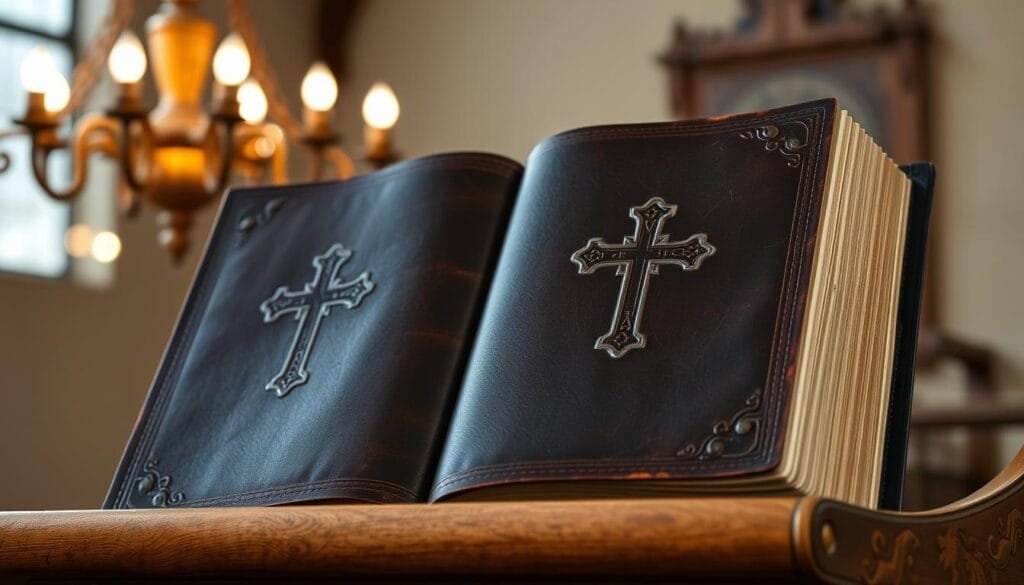Choosing the Right Catholic Bible Translations
This website contains affiliate links. As an Amazon Associate, I earn from qualifying purchases. The content on this website was created with the help of AI.
Reading Scripture is one of the most powerful ways to grow in faith, but not all Bibles are the same.
For Catholics, choosing a version that reflects the Church’s teaching and includes the full canon is essential.
That’s why understanding the differences among Catholic Bible translations matters.
From the poetic flow of the Douay-Rheims to the accessible language of the New American Bible, each translation offers a unique lens through which we encounter God’s Word.
Key Takeaways
- Catholic Bible versions include 73 books, reflecting centuries of doctrinal tradition.
- Translations like the NABRE and RSV2CE offer distinct approaches: formal equivalence vs. King James-inspired phrasing.
- Study Bibles such as the Didache and Ignatius editions provide apologetics and scholarly insights.
- Over 2,182 languages offer digital access, yet liturgical consistency remains a concern for the Church.
- Every Catholic Bible must carry Nihil Obstat and Imprimatur marks to ensure doctrinal integrity.
Let’s explore how these Catholic Bible translations help us draw closer to God. We’ll start by looking at what makes a Bible “Catholic.”
This includes its canon, approvals, and the wisdom it brings to our faith journey.
Understanding What Makes a Bible “Catholic”
Choosing a Bible that aligns with Catholic tradition begins with understanding what makes it unique.
A Catholic Bible contains all 73 books, including the deuterocanonical books, which are essential to our faith.
These seven books—Tobit, Judith, 1 and 2 Maccabees, Wisdom, Sirach, and Baruch—were confirmed by the Council of Trent. They are part of our sacred canon.
Their inclusion allows us to see the fullness of God’s message as passed down through the Church.
A Bible with an imprimatur has the Church’s seal of approval. This seal indicates that the text and notes adhere to Catholic teachings.
Look for the imprimatur on trusted editions, such as the New American Bible Revised Edition (NABRE) or the Ignatius Catholic Study Bible.
These marks show the Church’s extended care for Scripture.
Annotations in a Catholic study Bible help us understand Scripture through the lens of tradition. Editions like the Didache Bible connect verses to Catechism teachings.
- Revised Standard Version – Second Catholic Edition (RSV-2CE)
- Ignatius Bible Edition
- Hardcover
The St. Joseph Edition has notes based on papal writings. These resources help us see how Scripture guides us in sacraments, morality, and liturgy.
Popular Catholic Bible Translations and Their Features
Choosing the right Catholic Bible is key to your spiritual journey. Three translations stand out: the NABRE Bible, RSV Catholic Edition, and Jerusalem Bible.
Each has its own strengths to help you connect with Scripture.
- NABRE Bible: This translation is used in US liturgies. It strikes a balance between accuracy and readability. Released in 2011, it’s perfect for daily reading and study.
- RSV Catholic Edition: It’s known for its word-for-word accuracy. Theologians love it for deep study. Its formal style keeps the original text’s details.
- Jerusalem Bible: It’s famous for its literary beauty. It’s easy to read and keeps the poetic depth. The New Jerusalem Bible updates this with modern language.
Let’s compare their styles:
| Translation | Style | Best For |
|---|---|---|
| NABRE Bible | Dynamic equivalence | Liturgical use and daily prayer |
| RSV Catholic Edition | Formal equivalence | In-depth study and theological reflection |
| Jerusalem Bible | Literary interpretation | Engaging with Scripture’s poetic beauty |
These translations carry centuries of tradition. For a deeper dive, check out Bible study methods.
Remember, no single translation has all the answers. We suggest prayerful discernment to find the one that resonates with you.
Comparing Catholic Bible Translations for Different Needs
Every Catholic Bible version has its own purpose. Let’s find the proper catholic bible translations for your spiritual goals.
Whether you seek clarity in prayer or a deeper understanding, we’ll help you find it.
For Daily Reading and Prayer
For meditation, choose a Bible that’s easy to read. The Good News Bible Catholic Edition uses modern language.
The Jerusalem Bible’s poetic style also encourages reflection.
Look for Bibles with large fonts and lay-flat bindings. This makes reading and praying more comfortable.
For In-Depth Scripture Study
For deep study, pick a Catholic study Bible with scholarly notes. The RSV-CE2 Catholic Bible is accurate and easy to understand. The Ignatius Catholic Study Bible features essays on the topics of grace and sacraments.
The Catholic Study Bible (NABRE) includes maps and timelines for the Old Testament. The Didache Bible links verses to Catechism sections for study.

For Liturgical Use and Alignment with Mass Readings
Use the NABRE to follow Sunday readings. The CTS Catholic Bible marks Mass readings sections. This connects personal prayer with communal worship.
For New Catholics and Returning Believers
Start with the Word on Fire Bible for new Catholics. It uses the NRSV translation and includes essays on the Eucharist. The Good News Bible is simple and easy to understand.
The Word on Fire Gospels volume offers guided reflections. Starting small helps build confidence.
Physical Format Considerations When Selecting Your Catholic Bible
Choosing the correct Catholic Bible versions is more than just the translation. It’s about the physical design that makes you want to read it every day.
A Bible should feel like a trusted friend, not a heavy load. Let’s examine how binding, size, and extras make this sacred book unique.
| Format | Best Use | Key Features |
|---|---|---|
| Leather-bound | Lifelong use | Stylish durability, but heavier to carry |
| Compact | Travel | Easy to carry, smaller text |
| Large-print | Accessibility | Ease of reading for all ages |
Consider the differences in size and weight among various Catholic Bible versions. A journaling Bible features wide margins for notes, while smaller editions are compact enough to fit in bags.
Families may prefer hardcover Bibles, while students might opt for light paperbacks. Remember, Catholic Bibles have 1,400 to 2,000 pages, including extra books.

- Font size: 8-10pt for study, 10-12pt for daily reading
- Page quality: Thick paper prevents bleed-through during writing
- Supplements: Maps and concordances in study Bibles enhance understanding
Match your Bible with your needs. A leather-bound NABRE might be perfect for the family, while a compact NIV is great for school.
For a deeper study, consider exploring additional resources or devotionals to further enrich your journey.
Choose a Bible that fits your life. A well-loved Bible with clear text encourages daily reading. Whatever you pick, may it carry God’s word to you.
Conclusion: Making Your Catholic Bible Selection a Prayerful Decision
Choosing the right Catholic Bible is not about finding the “best” translation; it’s about finding the one that best suits your needs.
It’s about committing to read Scripture every day. The USCCB-approved translations, like the NABRE and RSV2CE, each have their strengths.
However, they won’t help unless you incorporate them into your spiritual routine.
Begin by praying for guidance as you consider various options. Think about what you want from your Bible.
Do you want one for liturgical use, in-depth study, or something easy for the whole family?
Many Catholics have more than one Bible. For example, the St. Joseph Edition is excellent for daily prayer.
The Ignatius Study Bible is perfect for those who want to dive deeper. The Great Adventure Bible is ideal for beginners, while the NABRE is well-suited for group worship.
Remember, the Church ensures that all approved translations are faithful to God’s word.
Whether you like the NAB’s clear language or the Douay-Rheims’ classic feel, what matters most is your reverence.
View Scripture as a conversation with God, using tools like Lectio Divina or daily Mass readings to grow your faith.
Let this choice motivate you to take action, not to find the perfect Bible. Many start with the St. Joseph Edition before moving to study Bibles.
Whatever you pick, may it help you grow, not just teach you facts. As Scripture says, “Faith without works is dead” (James 2:17). Read, pray, and live the Word with courage.









